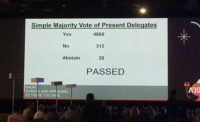Job Creation Focus of Ambitious Agenda
February 4th was Capitol Hill Day for AIA executives, board members, and component leaders. This year the objective of the annual lobbying effort was to demand that Congress take up an agenda that would, among other things, free up credit, expand tax incentives that encourage energy-efficient construction, and provide relief for small businesses. The excursion was part of Grassroots 2010, the AIA’s yearly leadership conference.
Setting the stage for the visits were rousing speeches by Representatives Kathy Castor (D. Florida) and Ed Perlmutter (D. Colorado), along with Adolpho Carrion Jr., director of President Obama’s Whitehouse Office of Urban Affairs Policy. All three reminded the architects of the power of advocacy, and admonished them to take seriously their influence in job-creating legislation.
“Through your innovative ideas,” said Castor, “this is the way we put people to work.”
Although the AIA’s Blueprint for Long Term Prosperity has many elements, for this trip to the Hill the lobbyists-for-a-day were asked to focus their discussions with lawmakers on five areas.
The first item on the agenda is to help struggling communities rebuild using Community Development Block Grants (CDBG). These would be applied to rehabilitating abandoned and neglected properties to create design and construction work. The long-term benefits of CDBG projects as vehicles for improving neighborhoods, and making them more sustainable, has a positive track record that is well documented.
Passage of two laws under consideration would create jobs by funding sustainability-related construction. One is a direct request that legislators cosponsor the Expanding Building Efficiency Incentives Act, which includes a tax deduction for green commercial buildings. The second is the 21st Century Green High Performing Schools Act, which has already passed the House. It would provide billions of dollars toward the modernization of K-12 schools. Although some congressional representatives consider school construction to be a local issue, the law would help hundreds of school districts that have put off desperately needed improvements due to a lack of funding.
Members were also asked to describe to their representatives how the economy has affected their own small businesses. The AIA is supporting the Small Business Financing and Investment Act, which would make available $44 billion in Small Business Administration loans. It is estimated that these would create or save approximately 1.3 million jobs. Architects were encouraged to share their experiences with the American Recovery and Reinvestment Act. ARRA requires employers to subsidize COBRA payments for the employees they lay off. The subsidy must be paid up front and is reimbursed through quarterly tax filings. But, this has caused cash-flow problems and ironically, in some cases has resulted in more layoffs.
The last point the AIA asked its members to drive home was that tight credit for commercial building has prevented the design and construction of hundreds projects. Much of this work is backed by pro formas that would under ordinary circumstances be considered sound. While no specific measure to alleviate credit stagnation was advocated, steps by Congress to loosen lending by banks would make a major difference for this profession and the economy in general.
Just before sending the audience out, Adolpho Carrion reminded attendees that President Obama’s agenda and the work that architects do have much in common. “When you go to see the members of Congress today, we ask you to champion urbanism and smart growth,” he said. “How we improve the human condition, in the place where people live their lives, is what architects struggle with, and what architects have fun with. We share the burden that you carry. If we didn’t in the past we do now under this president.”



Post a comment to this article
Report Abusive Comment